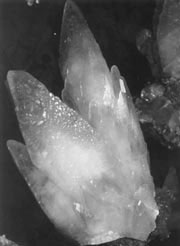
|
||||||
|
|
||||||
|
|
|
The color of crystals
Idiochromatic: Some minerals are nearly always the same color because certain light-absorbing atoms are an essential part of their crystal structure. These minerals are described as idiochromatic. For example, copper minerals are nearly always red, green or blue according to the nature of the copper present.: Allochromatic: A large number of minerals occur in a wide range of colors caused by impurities or light-absorbing defects in the atomic structure. For example, quartz, diamond, beryl, and corundum can be red, green, yellow, and blue. These minerals are described as allochromatic. Play of colors: The color os some minerals is really a play of colors like that seen in an oil slick or a soap bubble. This may be produced when the light is affected by the physical structure of the crystals, such as twinning or cleavage planes, or by the development duirng growth of thin films. Microscopic "intergrowths" of plate-like inclusions also interfere with the light.
|
||||
|
|
||||||
